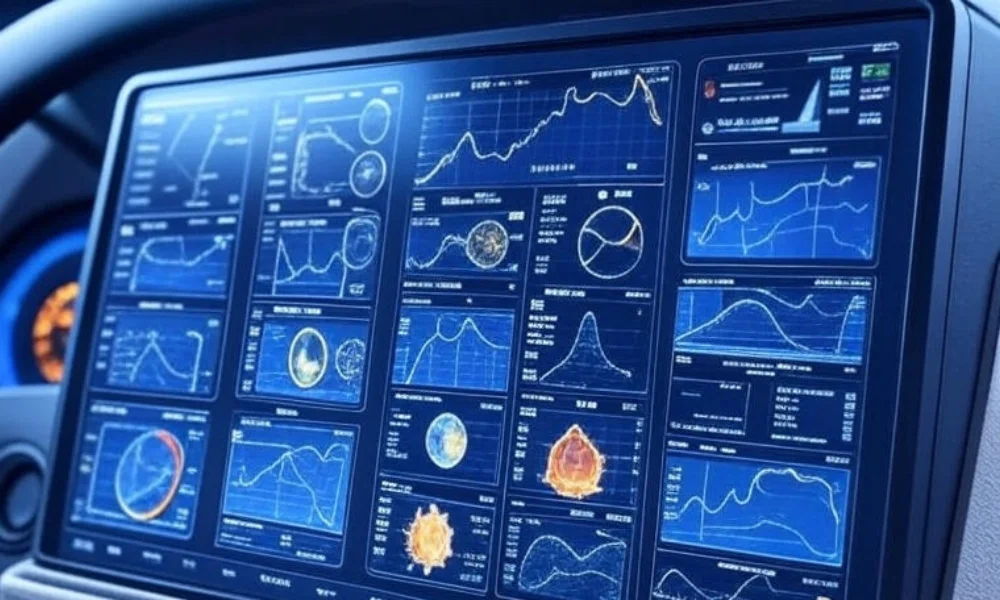Artificial Intelligence
Real-Time Freight Monitoring with AI: A Game-Changer for Service Quality
Real-time freight monitoring with AI is transforming U.S. logistics by delivering instant shipment visibility and predictive insights. Learn how this technology improves service quality, prevents delays, and keeps customers informed at every step.

When I first heard about Real-Time Freight Monitoring with AI, I imagined a future where shipments talk to me. I was observing all the changes in the locations and the temperatures as I was in the location. This helped me understand just how disempowering old fashioned freight tracking can be. The majority of systems just inform me where there was a freight hours earlier, not what is going on at the moment.
Definition:
Real-time freight monitoring with AI means using artificial intelligence and live data to track shipments instantly and proactively.
This change is ready within U.S. logistics industry, I think. In the current times, customers demand accurate information and quick solutions where delays are experienced. I have found out that AI is able to anticipate problems before they occur and provideactual responses in less time to clients. This is not only technology but also a new approach to managing freight operations, which, in effect, allows witnessing the quality of the service. I no longer wait on problems to occur with the use of AI. Things are that bad, I am already mending them before they get there.
What is Real-Time Freight Monitoring?
Real-time monitoring of freight has taught me that it is not all about knowing the location of the shipment. It is a matter of integrating live location, Condition, performance data into a single system that can be used by me. This solution will allow me to address the problems as soon as they begin to arise as opposed to after they have created delays. I observe how it alters the quality of the services by providing correct and proactive information at the appropriate time.
I observed that speed and depth is the major distinction between real-time monitoring and conventional tracking. This enables me to get a hand on the possible risks before they occur and act up without delaying.
Power that AI can bring to real-time freight monitoring:
How AI power best deliver cutting-edge freight tracking? I count on the AI to unite the GPS signals, IoT sensor read-outs, and even on the live weather or traffic data. This combination gives me a single dashboard where I am able to monitor everything occurring to my freight in real life. I get the sense of a control room in my pocket that does not experience any latency.
I have witnessed the application of predictive analytics in AI to identify issues before they impact on the delivery timing. Using previous patterns of shipment, it can predict when there might be delays, and advise it to take a more suitable route in real time. This implies that I am able to stem problems before they affect the customers and maintain a steady quality of service.
Important Advantages to Service Quality:
I have come across the benefits of AI in real-time freight monitoring by providing a considerable improvement in the on-time delivery rates. Presume knowing about the delays in the foreseeable future, I will be able to alter the routes or timetables without the consumer ever realizing that there might be an inconvenience. Such initiative implies a decrease in complaints and increase in trust among the clients who appreciate precision.
I would also recognize how AI powered updates make communication with my customers more efficient. Other than providing imprecise delivery time, I am able to deliver precise and realistic time. This form of transparency makes my service seem more personal and reliable creating long-term relations.
Use Cases:
I have observed the possibility in terms of large U.S. logistics companies that maintain freight tracked in real time with the help of AI via various modes of transportation. They also integrate the information of trucking, rail, air, and sea on one platform to have full visibility of the shipment. The integration enables them to resolve their problems before freight goes to critical transit points.
I can also observe this through the effects within temperature specific industries such as food and pharmaceuticals. AI can watch the conditions like temperature and humidity and inform me that something will jeopardize the quality of products. This guarantees the compliance, avoids the expensive wastage, and ensures that the customers remain happy that their deliveries are reliable and safe.
Issues and Solutions:
I know that the issue of data privacy and security is still of great concern in AI-enabled freight tracking. The systems installed by me should keep the shipments information and customer details out of unauthorized hands. This involves regular updates and high level encryption to ensure vulnerable information is not intercepted on the cyberspace.
Another problem that I encounter is getting older tracking systems that are still operational incorporated into AI. Legacy systems might even be unable to accommodate large live streams of data. This implies that I must typically require custom solutions or upgrades so that everything can work together and not interfere with each other.
AI in Freight Monitoring Foresight:
It is my view that hyper-automation will enable AI systems to automatically optimise routes and schedules in the near future without requiring human authorisation. This will not only speed up and give correctness to the operation of the freights but also leave me free to make strategic decisions. It will also cut down expensive delays that may strain customer relations.
Paired with blockchain is another area where I see AI, though one that only involves freight records. The technology will also enable me to confirm verified information on shipments in real time with the partners and the clients. It will promote trust, reduce disagreements and the quality of the service can be measured in a way that we never witnessed.
Conclusion:
From Tracking to Transforming Service Quality. I have learned that real-time freight monitoring with AI is not just a tracking tool but a service transformation. It will enable me to avoid problems, enhance communication, and have timely and regular quality shipments. This technology has transformed how I conduct my operations and how the customers feel my service.
In my opinion, visibility produced through AI will be the future of the freight. Its early adopters will be the most reliable and satisfied customers of the companies. I will also ensure I employ these tools to deliver the best service provision within the dynamic logistics industry. How do you feel about monitoring freight with AI in real time? Have you felt its impact in serving better in your experience? What aspect of AI-driven monitoring is most exciting to you?
-

 Artificial Intelligence8 months ago
Artificial Intelligence8 months agoHow to Use Grok AI: A Complete Guide
-

 Artificial Intelligence10 months ago
Artificial Intelligence10 months agoWhat is Artificial Intelligence? A Comprehensive Guide for Businesses and Enthusiasts
-

 Artificial Intelligence9 months ago
Artificial Intelligence9 months agoUnlocking the Power of Artificial Intelligence Tools
-

 Artificial Intelligence9 months ago
Artificial Intelligence9 months agoWhat is DeepSeek? Revolutionizing AI with Cutting-Edge Solutions
-

 Artificial Intelligence5 months ago
Artificial Intelligence5 months agoAI Technologies in Warehouse Automation:
-

 Artificial Intelligence5 months ago
Artificial Intelligence5 months agoPredictive Analytics for Demand Forecasting:
-

 Artificial Intelligence6 months ago
Artificial Intelligence6 months agoMeta’s AI Push: The Standalone Assistant App Set to Rival ChatGPT
-

 Artificial Intelligence5 months ago
Artificial Intelligence5 months agoHow Artificial Intelligence is Revolutionizing Logistics:


